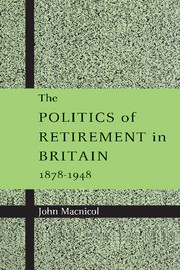Book contents
- Frontmatter
- Contents
- List of tables
- Acknowledgements
- Part I The campaign for old age pensions
- Part II Contributory pensions
- 7 The First World War and the 1919 Ryland Adkins Committee
- 8 From ‘all-in’ insurance to contributory pensions
- 9 Neville Chamberlain, the ‘New Conservatism’ and the 1925 Act
- Part III The debate on retirement pensions
- Part IV The ‘Beveridge revolution’
- Index
7 - The First World War and the 1919 Ryland Adkins Committee
Published online by Cambridge University Press: 01 October 2009
- Frontmatter
- Contents
- List of tables
- Acknowledgements
- Part I The campaign for old age pensions
- Part II Contributory pensions
- 7 The First World War and the 1919 Ryland Adkins Committee
- 8 From ‘all-in’ insurance to contributory pensions
- 9 Neville Chamberlain, the ‘New Conservatism’ and the 1925 Act
- Part III The debate on retirement pensions
- Part IV The ‘Beveridge revolution’
- Index
Summary
The effect of the First World War on pensioners was contradictory. On the one hand, the full employment conditions brought about by a war economy increased the labour force participation of pensioners, and thus some of them experienced a rise in income. At the same time, full employment boosted the political confidence of the labour movement and greatly expanded trade union membership (which roughly doubled in size from 1914 to 1920, from about four million to over eight million). This had an inevitable knock-on effect upon the militancy of pension campaigners (most of whom had roots in organised labour). As we have seen in the previous chapter, the labour movement had always regarded the 1908 Act as ‘unfinished business’, and was determined to pursue its goal of tax-funded, non-contributory pensions, universal in cover and with no means tests, paid if possible from the age of 60. Thus in early 1916 Asquith, as Prime Minister, received deputations from trade unionists and Labour MPs demanding higher pensions; but he refused their requests on grounds of cost. Pressure from the labour movement continued throughout the war, and in 1919 resolutions demanding a pension of £1 per week, payable at the age of 60, were passed at the annual conferences of the Labour Party, the Women's Cooperative Guild and the National Conference of Labour Women.
Even more indicative of the renewed militancy was the formation, on 1 July 1916, of the National Conference on Old Age Pensions (NCOAP) to campaign for the removal of the ‘thrift disqualification’ clauses and, secondarily, a raising of the pension level.
- Type
- Chapter
- Information
- The Politics of Retirement in Britain, 1878–1948 , pp. 167 - 180Publisher: Cambridge University PressPrint publication year: 1998



